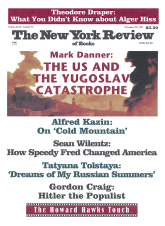By a coincidence, William Pfaff’s article “Eugenics, Anyone?” in which he described the killings at Steinhof, Vienna’s “model” psychiatric hospital, where until 1945 handicapped and “antisocial” children deemed “unworthy to live” were put to death by Nazi eugenicists and medical doctors, appeared in The New York Review [November 9] just as a remarkable exhibition was being shown in Vienna at the new Jewish Museum in the Dorotheergasse. On display were death masks and busts of Jews who were killed by the Nazis in a concentration camp outside Posen, then in German Silesia. Posen, renamed Posnan, became Polish after 1945.
The exhibition provides chilling evidence of how, under the Nazis, human beings became mere “things” or “specimens,” for the progress of pseudo-scientific research. The death masks and the actual skulls of the victims had been, as it were, mail-ordered in 1942 by one Dr. Josef Wastl, then head of the department of anthropology of Vienna’s renowned Museum of Natural History, from his colleagues at the University of Posen. From the correspondence on view in Vienna, it seems clear that the Posen faculty of anatomy were in the business of supplying such busts and the dissected skulls of dead Jews, Poles, and other Untermenschen to interested eugenicists throughout Europe. One of the caretakers at the faculty testified after the war that corpses from the nearby concentration camp would arrive almost daily at the faculty and their cut-off heads were “thrown into a basket like turnips.”
Until quite recently the masks, busts, and skulls formed part of the Vienna museum’s permanent collection. The skulls were finally, and somewhat reluctantly, released in 1991 for burial. The masks and busts remained in storage until the recent exhibition.
The correspondence, which formed the basis of the “collection,” is now displayed together with the masks. On February 25, 1942, Josef Wastl asked the Anatomical Institute of the Reich University at Posen whether it was interested in selling a few Judenschädel (Jew-skulls) to the Vienna museum. Gustav von Hirschheydt, chief dissector of the Posen Anatomical Institute, wrote back on March 4:
As per your letter of 25.2.42 I offer you Polenschädel /m and f/ at RM [i.e., Reichsmarks] 25,- …Hyperbrachycephaly is rare among the Polish Leichenmaterial [corpse-material], Brachycephaly is more frequent, Mesocephaly and Dolichocephaly very numerous. Judenschädel /m/ 20-50 years old I can also offer you at RM 25,- their exact age and place of birth can be supplied. The latter, however, means little in the case of Jews. Together with these Jew-skulls I am able to supply plaster death-masks of the individuals concerned at RM 15,- of especially typical Ostjuden. I can also prepare for you plaster busts, so that one can see the shape of the head (before dissection) and the frequently rather unique ears. The price of these busts would be 30-35 RM but because of a scarcity of time and of plaster I could not supply very many.
Heil Hitler!
G. v. Hirschheydt
Chief Dissector
Wastl promptly ordered twenty-nine Judenschädel, twenty-five death masks, and four busts, as well as fifteen Polenschädel at RM 1633. On June 2, Hirschheydt’s wife wrote Wastl to inform him that her husband had suddenly died of typhoid, the result of an infection. While dissecting a Judenleiche (Jew-corpse) he had, she wrote, been bitten by a Flecktyphus Judenlaus (typhoid Jewlouse). He was “a victim of his work, of research and science for which he had lived.” Before he collapsed unconscious in the lab he had asked her to inform his colleagues in Vienna that there would be a slight delay, but the ordered material would be delivered as promised.
Hirschheydt’s successor, one Hermann Voss, fulfilled the order on July 25. Wastl wrote back thanking him warmly, and expressing a hope that “another business connection will be possible in the foreseeable future.” He wrote Hirschheydt’s widow separately to express his “sincere condolences” at this loss of an important scientific “worker.” Her late husband’s plaster casts, he wrote, were “masterful.” He promised to display her husband’s picture at the planned showing of these masks and skulls at the museum. The show, he said, would be a lasting memorial to her husband’s “tragic fate.”
Wastl, a member of the Nazi Party since 1932 (long before the annexation of Austria by Germany in 1938) was classified in 1945 by the denazification court in Vienna as only “mildly incriminated.” He continued to live in an official apartment in the Schweizerhof wing of the Vienna Imperial Palace, the Hofburg. He was, however, relieved of his post at the museum and, at the age of fifty-three, retired with a full pension. Until his death in 1968 he was the vice-president of the Society of Anthropology of Austria. Professor Hermann Voss of Posen had a distinguished academic career in East Germany after the war. He was well-known in West Germany as the coauthor of the Voss-Herrlinger Handbook of Anatomy, a standard manual that in 1985 was in its seventeenth (West German) printing.
Advertisement
This Issue
November 20, 1997



